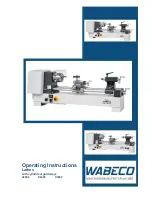
ADJUSTMENTS & OPERATION
Feed and Thread Selection
To set the desired feed rate and thread selection, it may be necessary to
change the gear configuration, refer to charts in Fig’s.3, 4, 5A & 5B. 36
feed speeds are possible in either the longitudinal or cross direction Fig.
5A. Once you have determined the job at hand (feed speed and thread),
place the selector knobs (A -D) Fig.15 in the appropriate positions.
If you desire Metric Threads, mm change gears must be installed as
indicated in chart Fig.4 and as described below.
Change gears
To obtain metric threads the proper change gears must be installed inside
the left side cover. Remove the 2 lock nuts which hold the left side cover
to the headstock and then remove the side cover.
Before changing gears, determine the threads per mm desired and look at
which gear configuration is needed, see chart Fig.4 as reference. The
large middle gear (A) Fig.16 is the only gear which does not get
interchanged. To replace the top gear (B), remove nut (C) which holds it in
place. Replace with appropriate gear and secure with nut. To replace the
bottom gear (D), remove gear cap screw (E). Once the change gears are
in place, reposition the side cover and lock it using the same lock nuts
removed previously.
Automatic Power Feed- Longitudinal or Cross Feed
The power feed lever (A) Fig.17 is used to engage either the longitudinal
or cross feed. This lever has a safety interlock to prevent accidental
engagement of the half nuts when the lathe is in feed mode. There are 3
positions; the upper position engages the power longitudinal feed, the
lower position engages the power cross feed and the center position is the
disengaged position.
Make sure the correct gear configuration is set as shown in charts Fig.3,
4, 5A & 5B. Place the feed/thread selector to ANY position and make sure
the thread cutting engagement lever (B) is disengaged before operating.
Thread Cutting Operation
In order to obtain the desired thread, all change gears must be installed in
accordance to the thread charts. Failure to do so will give incorrect
threads.
Move the thread cutting engagement lever (B) Fig.17 downwards, this will
make it engage with the leadscrew for longitudinal travel of the carriage.
Make sure the power feed lever (A) is disengaged (in neutral position)
before operating the thread cutting engagement lever (B), note: a safety
interlock prevents accidental engagement of the half nuts when the lathe
is in feed mode.
FIGURE 15
FIGURE 16
FIGURE 17
Thread Cutting Dial Operation
The thread cutting dial is used to engage the half nuts with the
leadscrew in the same thread that has been previously cut.
Please note: Use any line of the dial for even pitches of threads,
but for odd pitches of threads you must use the same starting
line.
Example: When cutting a shaft with 10 T.P.I., engage the half
nuts at any number on the thread dial, when creating an odd
pitch, if you start the cut using 1 or a 3, continue to use the 1 or
the 3 until the thread is finished. See Fig.7.


















